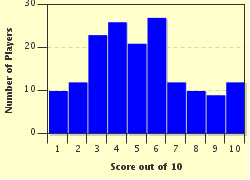Quiz Answer Key and Fun Facts
1. Though this self-portrait was originally of a more sickly looking man, I have filled him in to look healthier. Where in the world was this artist born?
2. Vincent Van Gogh made a lot of paintings of sunflowers. Unlike Claude Monet, who was wealthy and had his own gardens and grounds to paint in, Vincent painted what was around him. Where were most of his sunflower paintings done?
3. This is a copy I painted of a detail from a painting by Claude Monet. Where does this scene come from?
4. Pablo Picasso painted the "Blue Nude" in shades of blue, grey and black. Which period followed the artist's 'blue' one?
5. This copy of a self-portrait of Vincent Van Gogh shows a much changed man from the self-portrait made two years earlier, one who has suffered mutilation and despair. Where in France was the painting made?
6. This painting by Winslow Homer depicts a man, possibly a runaway slave, caught in his mangled and drifting boat. Where in the world is he?
7. Vincent again! Which museum acquired this painting in 1958?
8. Many afficionados of Vincent Van Gogh consider this painting to be his last or one of his last as he was said to have been out in the fields painting before he ran into the town with a bullet wound. He died two days later. Where in the world is he buried?
9. This is a combination of Vincent's "Starry Night" and some evidence of Dr. Who visiting during the 19th century. Daleks are attempting to exterminate things, as is their way. Where is this place?
10. This is a copy of an Andrew Wyeth painting. Where in the world is the dog napping?
Source: Author
alexis722
This quiz was reviewed by FunTrivia editor
looney_tunes before going online.
Any errors found in FunTrivia content are routinely corrected through our feedback system.

